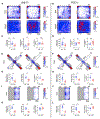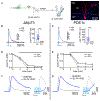Glutamate released by Cajal-Retzius cells impacts specific hippocampal circuits and behaviors
- PMID: 35584670
- PMCID: PMC9190441
- DOI: 10.1016/j.celrep.2022.110822
Glutamate released by Cajal-Retzius cells impacts specific hippocampal circuits and behaviors
Abstract
The impact of Cajal-Retzius cells on the regulation of hippocampal circuits and related behaviors is unresolved. Here, we directly address this issue by impairing the glutamatergic output of Cajal-Retzius cells with the conditional ablation of vGluT2, which is their main vesicular glutamate transporter. Although two distinct conditional knockout lines do not reveal major alterations in hippocampal-layer organization and dendritic length of principal neurons or GABAergic cells, we find parallel deficits in specific hippocampal-dependent behaviors and in their putative underlying microcircuits. First, conditional knockout animals show increased innate anxiety and decreased feedforward GABAergic inhibition on dentate gyrus granule cells. Second, we observe impaired spatial memory processing, which is associated with decreased spine density and reduced AMPA/NMDA ratio of postsynaptic responses at the perforant- and entorhino-hippocampal pathways. We conclude that glutamate synaptically released by Cajal-Retzius cells is critical for the regulation of hippocampal microcircuits and specific types of behaviors.
Keywords: CP: Neuroscience; anxiety; development; interneuron; memory; optogenetics; spine; transporter.
Copyright © 2022 The Author(s). Published by Elsevier Inc. All rights reserved.
Conflict of interest statement
Declaration of interests The authors declare no competing interests.
Figures




Similar articles
-
Optogenetic activation of cajal-retzius cells reveals their glutamatergic output and a novel feedforward circuit in the developing mouse hippocampus.J Neurosci. 2014 Sep 24;34(39):13018-32. doi: 10.1523/JNEUROSCI.1407-14.2014. J Neurosci. 2014. PMID: 25253849 Free PMC article.
-
Progesterone receptor expression in cajal-retzius cells of the developing rat dentate gyrus: Potential role in hippocampus-dependent memory.J Comp Neurol. 2018 Oct 1;526(14):2285-2300. doi: 10.1002/cne.24485. Epub 2018 Sep 19. J Comp Neurol. 2018. PMID: 30069875 Free PMC article.
-
Novel GABAergic circuits mediating excitation/inhibition of Cajal-Retzius cells in the developing hippocampus.J Neurosci. 2013 Mar 27;33(13):5486-98. doi: 10.1523/JNEUROSCI.5680-12.2013. J Neurosci. 2013. PMID: 23536064 Free PMC article.
-
Cajal-Retzius cells and GABAergic interneurons of the developing hippocampus: Close electrophysiological encounters of the third kind.Brain Res. 2018 Oct 15;1697:124-133. doi: 10.1016/j.brainres.2018.07.028. Epub 2018 Jul 30. Brain Res. 2018. PMID: 30071194 Free PMC article. Review.
-
The dual glutamatergic-GABAergic phenotype of hippocampal granule cells.Trends Neurosci. 2005 Jun;28(6):297-303. doi: 10.1016/j.tins.2005.04.005. Trends Neurosci. 2005. PMID: 15927685 Review.
Cited by
-
Postnatal persistence of hippocampal Cajal-Retzius cells has a crucial role in the establishment of the hippocampal circuit.Development. 2024 Jan 1;151(1):dev202236. doi: 10.1242/dev.202236. Epub 2024 Jan 9. Development. 2024. PMID: 38095282 Free PMC article.
-
Developmental Cajal-Retzius cell death contributes to the maturation of layer 1 cortical inhibition and somatosensory processing.Nat Commun. 2024 Aug 1;15(1):6501. doi: 10.1038/s41467-024-50658-6. Nat Commun. 2024. PMID: 39090081 Free PMC article.
-
A Versatile Strategy for Genetic Manipulation of Cajal-Retzius Cells in the Adult Mouse Hippocampus.eNeuro. 2023 Oct 18;10(10):ENEURO.0054-23.2023. doi: 10.1523/ENEURO.0054-23.2023. Print 2023 Oct. eNeuro. 2023. PMID: 37775311 Free PMC article.
-
Inhibitory effect of berberine on morphine tolerance and hyperalgesia in mice.J Tradit Chin Med. 2023 Oct;43(5):915-924. doi: 10.19852/j.cnki.jtcm.20230802.006. J Tradit Chin Med. 2023. PMID: 37679979 Free PMC article.
-
Calcium Signaling during Cortical Apical Dendrite Initiation: A Role for Cajal-Retzius Neurons.Int J Mol Sci. 2023 Aug 19;24(16):12965. doi: 10.3390/ijms241612965. Int J Mol Sci. 2023. PMID: 37629145 Free PMC article.
References
Publication types
MeSH terms
Substances
Grants and funding
LinkOut - more resources
Full Text Sources
Molecular Biology Databases
Miscellaneous

